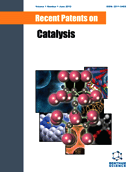Abstract
The paper is reviewing the patents and journal papers treating catalysis and engineering issues involved in the dimethyl ether (DME) production from synthesis gas. The necessary catalysts include components active for the two reactions defining this process: carbon oxides hydrogenation to methanol and methanol etherification to DME respectively. For the first reaction, amongst the dozens of catalytic materials proposed, the largest utilization has the classical methanol synthesis catalyst Cu-ZnO-Al2O3, sometimes modified with ingredients contributing to the increase of the copper dispersion and stability. Good activity and selectivity for methanol etherification have the solid acids with moderate acidity (γ- Al2O3, zeolites, mesoporous materials etc.). An important challenge in the formulation of the bi-functional catalyst and the reactor design is the prevention or limitation of deactivating phenomena: copper sintering, coking of acidic components and metal ions migration. Particularly, a good temperature control is necessary, due to the important overall process exothermicity. Demonstration plants having capacities up to 100 t DME/day, based on tri-phase slurry reactors or jacketed multi-tubular reactors, are already in successful operation. An important drawback of the one-step DME synthesis process is the formation of CO2 as secondary product, difficult to separate from DME mixture. Patented technologies are based on separation by extraction with selective solvents or by refrigeration and distillation. Efficient and environmentally friendly design solutions are integrating the DME synthesis line with hydrocarbon reforming units, recycling and valorizing CO2 byproduct. Studies are also in progress, aiming to develop technologies for DME synthesis by CO2 hydrogenation.
Keywords: Bi-functional catalyst methanol, catalytic reactor, deactivation, kinetics, separation, synthesis gas.
 105
105

